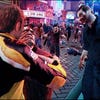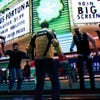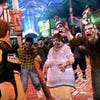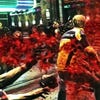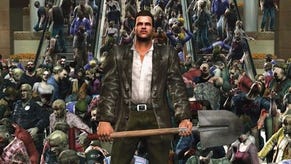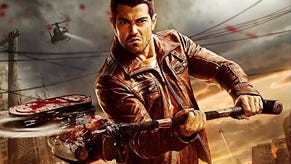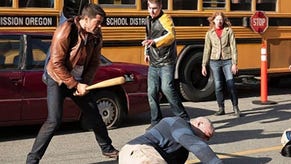Dead Rising 2
Dusk of the dead.
These relatively long-term pressures are then buffered by a near-constant stream of third-party cries for help. Arriving on your to-do list by way of Greene's pager, these draw attention to Fortune City's trapped, lost, or confused patrons, each one in need of rescuing and returning to the mall's safe house. It might be an old lady stuck in the rear of a toyshop, still fretting over what present to buy her grandson and unaware of the zombie apocalypse outside the sliding doors, who must be carried in Greene's arms through the sea of undead. Or it might be a young redneck couple trapped inside a burning office. The game's lasting appeal comes not from comedy bloodsport, but from carving a path through the peril in order to save these survivors, and return them to the safe house unscathed.
The incentive to do this is built into the game's economy, which rewards you with huge amounts of Prestige Points for every uninfected person returned to safety, levelling Greene and thereby increasing his health and abilities. But the drive to save others is more than a detached, mathematical one written in the game's systems.
Somehow, set against the relentless assault of violence against these undead entities, the value of life is heightened. The thrill of pulling others from the sea of danger is a familiar one in videogames, but it's usually a mission spread over the course of an entire game: save Peach from Bowser, rescue Zelda from Ganondorf. Here the sheer number of cries for help, and the overwhelming odds, ensure that the sense of camaraderie and companionship forged in those ten minutes between first contact and safety is irresistible. You gotta save 'em all.
This is made easier by the fact that you can tool your comrade up with any spare weaponry you have to hand - and the AI is competent at looking after itself and covering your back. It soon becomes apparent that a well-armed entourage is invaluable. Each team member has his or her own health bar, shown on screen at all times, while pressing food or drink into their hands will replenish life.
It can sometimes be frustrating hammering out constant calls for those you're rescuing to keep up, and if you rush too far ahead, they'll often be left awkwardly behind in a previous area. But the thrill of delivering a line of previously lost souls to safety never loses its edge, just as the disappointment of someone dying before you could get to them never fails to sting.
Painful, too, is losing half an hour's play in the cold embrace of a zombie because you failed to save in one of the game's toilets regularly enough. While there are now three save slots on offer (the first game only offered one), the system used to record progress can appear archaic and unforgiving. But viewed in the right way, the risk required to save your game, often by taking dangerous excursions through zombie-infested areas, is part of the game's appeal.
For all its comedy outfits and outlandish weaponry, Dead Rising 2's environment is relentlessly hostile, and failure to treat it with necessary caution is punished in the most extreme terms. The save mechanic highlights this truth, which is only gently softened by the option to restart the game while keeping your current character level.
Nevertheless, there are idiosyncrasies which cannot be viewed so generously. Talking to survivors in the midst of a zombie attack in order to persuade them to join you is a fussy frustration, just as picking out the exact item you want from a crowded shelf is an inexact chore. The lengthy load times between each area, while no doubt necessary to allow for the vast numbers of zombies on screen, interrupt the rhythm of play too often and for too long. Boss battles, either those that form part of the story missions or the optional encounters with 'psychopaths' - survivors driven mad by the outbreak who turn on you – lack finesse, as does the direction of the cut-scenes that introduce them.
Guns, when you do find them, lack kickback and seem to run contrary to the spirit of the make-do approach to weaponry elsewhere in the game. The lack of a minimap means that, until you have the mall mapped in your mind, you'll often find yourself lost. All these flaws, just as visible here as they were in the game's predecessor, grate, ensuring that Dead Rising 2 is best played in hour-long doses so they don't have chance to overwhelm its wider, greater strengths.
But despite the low-level irritations, Dead Rising 2's focus and determination win you over. Its assured grasp of what the game is and what it isn't is worth celebrating. The harder edges of the first game have been softened a little, no doubt thanks to the involvement of a Western studio. The result is a balanced game, at once idiosyncratic, infuriating, funny and ultimately compelling. In both its story and its systems, it holds life and undeath in delicate tension; and as a result, all the loud-mouth college humour and violence fail to mask its tender heart.
Dead Rising 2 is now available for PC, PS3 and Xbox 360.



